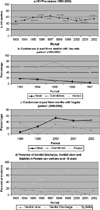Correlates and trend of HIV prevalence among female sex workers attending sexually transmitted disease clinics in Pune, India (1993-2002)
- PMID: 16340482
- PMCID: PMC3516676
- DOI: 10.1097/01.qai.0000179428.49907.6d
Correlates and trend of HIV prevalence among female sex workers attending sexually transmitted disease clinics in Pune, India (1993-2002)
Abstract
In India, substantial efforts have been made to increase awareness about HIV/AIDS among female sex workers (FSWs). We assessed the impact of awareness regarding safe sex in a cohort of FSWs by studying trends in HIV prevalence, sexually transmitted diseases (STDs), and risk behaviors measured from 1993 to 2002 in Pune, India. A total of 1359 FSWs attending 3 STD clinics were screened for HIV infection, and data on demographics, sexual behaviors, and past and current STDs were obtained. The overall HIV prevalence among FSWs was 54%. Not being married (adjusted odds ratio [AOR] = 1.74, 95% confidence interval [CI]: 1.17 to 2.59), being widowed (AOR = 2.10, 95% CI: 1.16 to 3.80), inconsistent condom use (AOR = 1.60, 95% CI: 1.02 to 2.50), clinical presence of genital ulcer disease (GUD; AOR = 1.66, 95% CI: 1.07 to 2.56), and genital warts (AOR = 4.70, 95% CI: 1.57 to 14.08) were independently associated with HIV infection among FSWs. The prevalence of HIV remained stable over 10 years (46% in 1993 and 50% in 2002; P = 0.80). The prevalence of GUD decreased over time (P < 0.001), whereas that of observed genital discharge remained stable. Reported consistent condom use as well as the proportion of FSWs who refused sexual contact without condoms increased over time (P < 0.001). These data collectively suggest that safe sex interventions have had a positive impact on FSWs in Pune, India.
Figures
Similar articles
-
Risk factors for HIV infection in people attending clinics for sexually transmitted diseases in India.BMJ. 1995 Jul 29;311(7000):283-6. doi: 10.1136/bmj.311.7000.283. BMJ. 1995. PMID: 7633230 Free PMC article.
-
Same-sex behavior and high rates of HIV among men attending sexually transmitted infection clinics in Pune, India (1993-2002).J Acquir Immune Defic Syndr. 2006 Dec 1;43(4):483-90. doi: 10.1097/01.qai.0000243097.27029.b7. J Acquir Immune Defic Syndr. 2006. PMID: 17019372
-
High HIV prevalence among a high-risk subgroup of women attending sexually transmitted infection clinics in Pune, India.J Acquir Immune Defic Syndr. 2006 Jan 1;41(1):75-80. doi: 10.1097/01.qai.0000174653.17911.4a. J Acquir Immune Defic Syndr. 2006. PMID: 16340477
-
A cross-sectional study of sexually transmitted pathogen prevalence and condom use with commercial and noncommercial sex partners among clients of female sex workers in southern India.Sex Transm Dis. 2013 Jun;40(6):482-9. doi: 10.1097/OLQ.0b013e3182904a9a. Sex Transm Dis. 2013. PMID: 23677022
-
A review of human immunodeficiency virus infection in India.J Acquir Immune Defic Syndr (1988). 1994 Nov;7(11):1185-94. J Acquir Immune Defic Syndr (1988). 1994. PMID: 7932085
Cited by
-
Indicators of mobility, socio-economic vulnerabilities and HIV risk behaviours among mobile female sex workers in India.AIDS Behav. 2012 May;16(4):952-9. doi: 10.1007/s10461-011-9937-7. AIDS Behav. 2012. PMID: 22186960 Free PMC article.
-
Large-scale STI services in Avahan improve utilization and treatment seeking behaviour amongst high-risk groups in India: an analysis of clinical records from six states.BMC Public Health. 2011 Dec 29;11 Suppl 6(Suppl 6):S10. doi: 10.1186/1471-2458-11-s6-s10. BMC Public Health. 2011. PMID: 22970436 Free PMC article.
-
AIDS in India.Postgrad Med J. 2006 Sep;82(971):545-7. doi: 10.1136/pgmj.2006.044966. Postgrad Med J. 2006. PMID: 16954447 Free PMC article.
-
A systematic review and meta-analysis of risk factors for sexual transmission of HIV in India.PLoS One. 2012;7(8):e44094. doi: 10.1371/journal.pone.0044094. Epub 2012 Aug 28. PLoS One. 2012. PMID: 22937158 Free PMC article.
-
Prevalence and assessment of clinical management of sexually transmitted infections among female sex workers in two cities of India.Infect Dis Obstet Gynecol. 2011;2011:494769. doi: 10.1155/2011/494769. Epub 2011 Jun 22. Infect Dis Obstet Gynecol. 2011. PMID: 21747642 Free PMC article.
References
-
- National AIDS Control Organization. HIV Estimates 2003. Facts and figures, 2003. Available at: http://www.nacoonline.org/facts_overview.htm.
-
- National AIDS Control Organization. Monthly updates on AIDS. Facts and figures, September 30, 2004. Available at: http://www.nacoonline.org/facts_reportsept.htm.
-
- Weniger BG, Limpakarnjanarat K, Ungchusak K, et al. The epidemiology of HIV infection and AIDS in Thailand. AIDS. 1991;5(Suppl):S71–S85. - PubMed
-
- Thuy NT, Lindan CP, Phong TH, et al. Predictors of visits to commercial sex workers by male attendees at sexually transmitted diseases clinics in southern Vietnam. AIDS. 1999;13:719–725. - PubMed
Publication types
MeSH terms
Grants and funding
LinkOut - more resources
Full Text Sources
Medical
Research Materials
Miscellaneous


